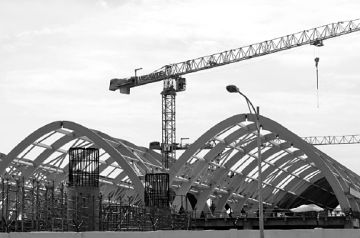More flight routes from Cebu to Australia, Southeast Asia, Europe eyed

The Terminal 2 of the Mactan Cebu International Airport, when completed in 2018, is expected to increase the airport’s capacity to handle more people arriving and leaving the airport from 4.5 million to 11 million in a year.
CDN PHOTO/TONEE DESPOJO
More Cebu connections
Expect an increase in tourist arrivals from Australia, Europe and other Southeast Asian countries in the next two years in Cebu if plans to introduce more routes to these areas will be realized.
Andrew Acquaah Harrison, who is the chief executive advisor of GMR Megawide Cebu Airport Corporation (GMCAC), said that they plan to introduce more direct international routes that connect Cebu to these areas including China, Japan and South Korea.
Harrison said that there is a current over dependency on the Korean tourist market, and they are looking to help promote more diversity by opening up more flights to Cebu.
“We were told that some 40 percent to 90 percent of the guests in hotels are Koreans; while that’s good, we also need to promote more diversity,” said Harrison, during a briefing on the updates of the construction of the new terminal project at the Mactan Cebu International Airport.
GMCAC operates the Mactan airport.
He said that while it is good to see more and more Koreans here, much of the businesses that the Korean tourists bring in are limited among themselves as they also hire Korean guides and only dine and stay at Korean-owned establishments.
“I think we should start bringing in more of the higher-spending and longer-staying Europeans,” he said.
Harrison also cited the addition of more international flights connecting to Cebu.
Int’l flights
As of March this year, 10 new international flights had been added, he said.
“As of now, Cebu is connected to 17 international destinations and 27 domestic destinations with 20 partner airline carriers. The international destinations are mainly to the North and Southeast Asia and also include long-haul flights to Los Angeles and Dubai and seasonal chartered flights to China,” he said.
Six new international carriers also now fly directly to Cebu, including Xiamen Air, China Eastern, Eva Air, Vanila Air, T’Way Air and Emirates.
“As we continue to expand more flights, it is a clear indication that Cebu is no longer just a secondary airport. It is a viable choice connecting the rest of the Philippines to the world,” said GMCAC president Louie Ferrer in a statement.
Terminal 2 update
Harrison and Ferrer shared the firm’s plans especially with the expected completion of the new airport terminal – the Terminal 2.
Harrison said the construction works are up to date for the set delivery of the new terminal by 2018.
“Construction works started in July 2015 with a target completion in June 2018. As of now, we are up to date,” he said.
Located beside the Terminal 1, Terminal 2 spans 6.5 hectares with a modular expansion capacity which will represent Cebu as an efficient transient hub.
Terminal’s features
Harrison said the features of the new terminal will blend modern building materials and Cebuano culture and heritage with a design that recalls the shape of a “bangka” or a native canoe that will represent Cebu’s cultural inheritance.
The new terminal will have a two-level forecourt segregating the Arrival and Departure passengers fully integrated with a landside development.
It will have 48 check-in counters which according to Harrison can be expanded to 72 should the need arises.
“It shall have provisions for seven passenger boarding bridges and expandable to 12 serving wide and narrow body aircrafts,” he said.
47 escalators
The new terminal will have 47 escalators, an underground car parking facility that can accommodate 750 cars and a drop-off area with an 18 meter canopy that is completely covered.
Like the Terminal 1, it shall have a wide array of retail and dining choices including a mall and a hotel.
Once the Terminal 2 is completed and becomes operational, Harrison said they would start refurbishing the Terminal 1, which they plan to fully serve domestic passengers soon while Terminal 2 would serve the international passengers.
11M capacity
The airport’s capacity will then rise to 11 million from only 4.5 million now.
Harrison said they would expect to end the year with 10 million passengers using the airport.
He also said that with the new terminal, the capacity of the airport could be expanded to up to 29 million as the new terminal would have two expansion zones that could be used once traffic in the airport goes beyond 11 million.
Disclaimer: The comments uploaded on this site do not necessarily represent or reflect the views of management and owner of Cebudailynews. We reserve the right to exclude comments that we deem to be inconsistent with our editorial standards.
